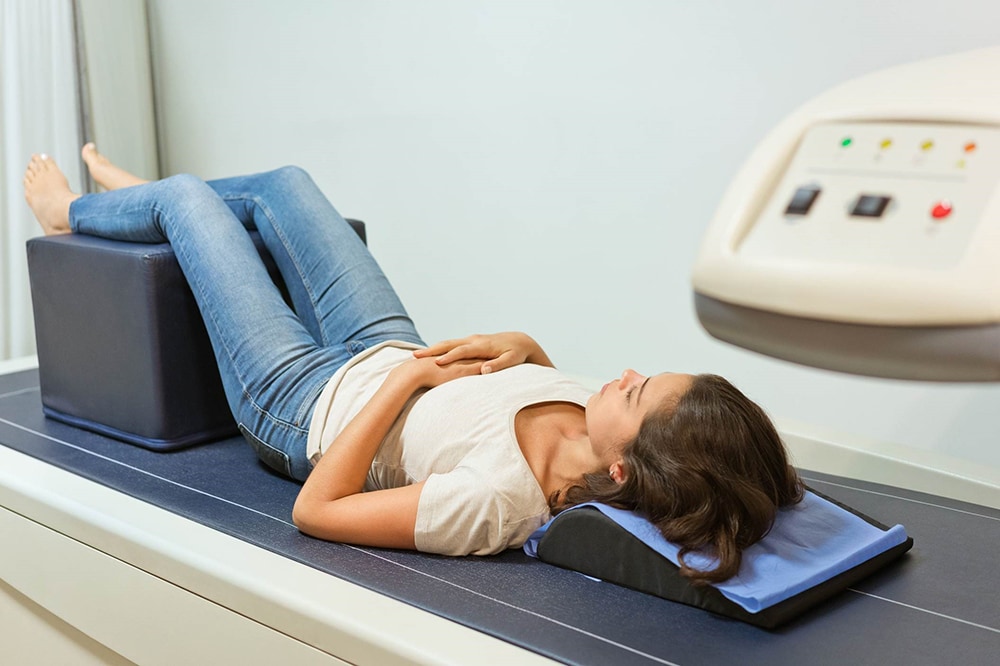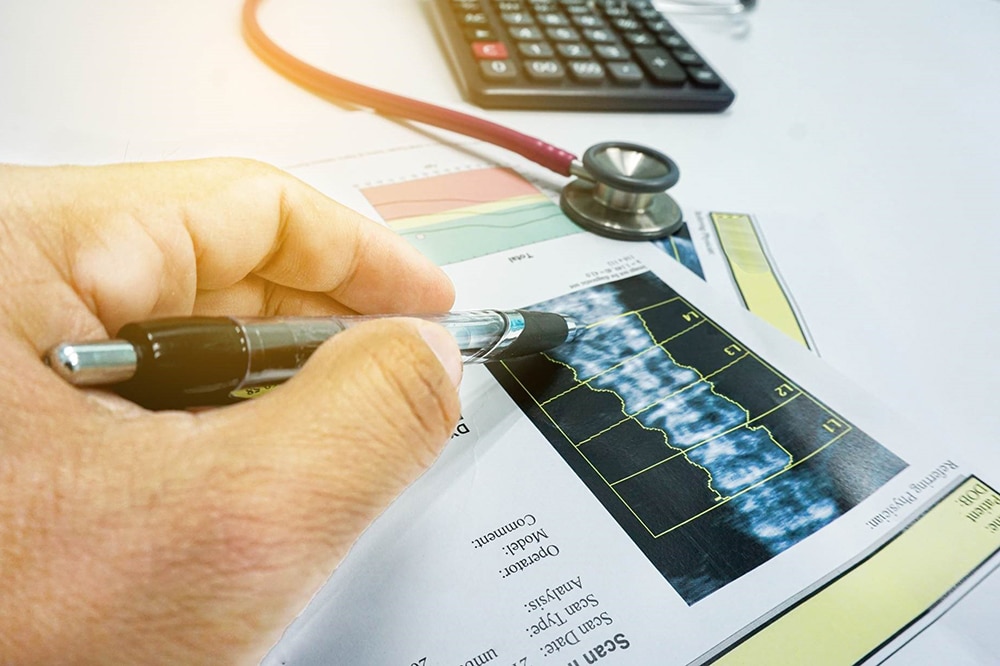Radiation in Healthcare: Bone Density (DEXA Scan)


DEXA (dual x-ray absorptiometry) scans measure bone density (thickness and strength of bones) by passing a high and low energy x-ray beam (a form of ionizing radiation) through the body, usually in the hip and the spine. This procedure is important for diagnosing (seeing if someone has) osteoporosis or bone thinning and may be repeated over time to track changes in bone density.
The amount of radiation used in DEXA scans is very low and similar to the amount of radiation used in common x-rays. Although we all are exposed to ionizing radiation every day from the natural environment, added exposures can slightly increase the risk of developing cancer later in life.
What You Should Know
Your healthcare provider may recommend a DEXA scan to test for osteoporosis or thinning of your bones.
Screening for osteoporosis is recommended for women who are 65 years old or older and for women who are 50 to 64 and have certain risk factors, such as having a parent who has broken a hip. However, there are other risk factors for osteoporosis besides age and gender, such as some intestinal disorders, multiple sclerosis, or low body weight. Your healthcare provider may recommend a DEXA scan if you have any of these other risk factors. DEXA scans should be used when the health benefits outweigh the risks. Talk to your healthcare provider about any concerns you have before a DEXA scan.
- Nearly 1 in 5 women and 1 in 20 men over the age of 50 are affected by osteoporosis.
- Osteoporosis increases the risk for broken bones and can have serious effects in older adults.
What To Expect
Before the procedure
- Make sure to let your healthcare provider or radiologist (medical professional specially trained in radiation procedures) if you are pregnant or think you may or could be pregnant.
- Dress in loose, comfortable clothing. Don’t wear anything that has metal on it like buckles, buttons, or zippers. Metal can interfere with test results.
During the procedure
- You may be asked to remove jewelry, eyeglasses, and any clothing that may interfere with the imaging.
- You will lay on a table and the radiologist or medical assistant will position your legs on a padded box. They also may place your foot in a device so that your hip is turned inward.
- While the image is taken, lay still and follow instructions. You may need to hold your breath for a few seconds.
After the procedure
- The procedure typically lasts about 15-20 minutes.
- Your healthcare provider will follow up with you with your results. They will show a T-score and a Z-score. The T-score shows how your bone density compares to the optimal peak bone density for your gender. The Z-score shows how your bone density compares to the bone densities of others who are the same age, gender, and ethnicity.
Benefits and Risks of DEXA Scans
DEXA scans are different from other imaging procedures because they are used to screen for a specific condition.
Benefits:
- Detects weak or brittle bones to help predict the odds of a future fracture
- Determines if bone density is improving, worsening, or staying the same
- Can help you and your healthcare provider come up with plans to improve your bone strength and prevent worsening conditions
Risks:
- A very slight increase in possibility of future cancer, similar to the risks from x-rays.
Related Links
ACR
ASRT
Image Gently
- What Parents should Know about Medical Radiation Safety pdf icon[PDF – 430 kb]external icon
- Educational Materialsexternal icon
EPA
- RadTown USA Medical X-Raysexternal icon
- Radiation Protection Guidance for Diagnostic and Interventional X-Ray Proceduresexternal icon
US National Library of Medicine
FDA
- Reducing Radiation from Medical X-raysexternal icon
- Pediatric X-ray Imaging external icon
- Radiology and Children: Extra Care Requiredexternal icon
- X-Rays, Pregnancy and Youexternal icon
- Medical X-rays: How Much Radiation are You Gettingexternal icon
Image Gently
- What Parents should Know about Medical Radiation Safety pdf icon[PDF – 430kb]external icon
- Educational Materialsexternal icon
EPA
- RadTown USA Medical X-Raysexternal icon
- Radiation Protection Guidance for Diagnostic and Interventional X-Ray Proceduresexternal icon
US National Library of Medicine